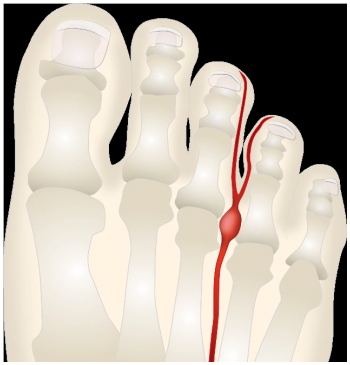including Morton’s Neuroma
Information
Metatarsalgia is the medical term to describe pain in the ball of the foot. It is not a diagnosis but a term to describe the symptoms. Patients may complain of pain in the ball of the foot – anything from an ache to several hot burning pain and often describe that they are walking on ‘pebbles’
The pain can be from several structures:
- Pain from overload of the bones (including stress fractures)
- Pain from nerves (Morton’s Neuroma)
- Pain from failure of soft tissues (plantar plate tears and joint subluxation)
The reason for failure of these structures are usually biomechanical – i.e. altered load bearing across the front of the foot. This can be for many reasons, for example:
- Hallux Rigidus or hallux valgus leading to altered load across the forefoot
- Tight calf muscle leading to increased load in the forefoot
- Overtraining leading to overload of the tissues.
- Deformity of the foot leading to uneven load bearing.
- Obesity leading to overload
- Generalised muscle weakness or asymmetrical muscle weakness
- Generalised arthritic conditions such as Rheumatoid arthritis, gout
Non-surgical Treatments
Most patients will improve with non-operative interventions. Insoles to take the pressure off the ball of the foot or to balance the foot will generally be helpful.
Physiotherapy will be helpful in patients with muscle weakness or imbalance.
Surgical Treatments
This is often to treat the underlying cause – e.g. treating a hallux valgus deformity, but in some cases will be to break and realign the metatarsals, or to remove the nerve in the cases of Morton’s neuroma.
Morton’s neuroma
This is a specific cause of Metatarsalgia where a nerve is affected.
People with Morton’s neuroma usually complain of pain that can start in the ball of the foot and shoot into the affected toes (middle toes). Some people describe the pain that they feel as being like walking on a stone or a marble. Symptoms can be made worse with high-heeled shoes. Patients may also experience some numbness between the affected toes.
The exact cause of Morton’s neuroma is not known but it is thought to develop as a result of long-standing (chronic) stress and irritation of the nerve to the toes. This may be due to the nerve being squashed (compressed), rubbed, or stretched. Some thickening (fibrosis) and swelling may then develop around a part of the nerve. We know that wearing narrow shoes, thin soled or flimsy shoes make the pain worse.
Other factors such as tight muscles at the back of the leg (Triceps surae) can reduce the ability of the foot to bend upwards at the ankle. This leads to increased pressure on the front (ball) of the foot and can give rise to neuroma symptoms. This is best treated with physiotherapy to stretch the muscles, but sometimes surgery is necessary. Sometimes the neuroma occurs with other problems in the foot such as a bunion of the big toe joint, arthritis of the big toe joint or deformity of the small toes. These problems may need to be addressed before the neuroma symptoms improve. Sometimes Morton’s neuroma symptoms occur with other medical conditions such as rheumatoid arthritis, diabetes or conditions affecting the nerves (neuropathy).

Morton’s neuroma is usually diagnosed by symptoms and examining the foot.
Pain in the web space at base of toes, a “Mulder’s click” and a positive metatarsal squeeze test are indicative of a neuroma.
Sometimes an ultrasound scan is ordered to confirm the diagnosis but this is not always necessary. Such tests are not always accurate and diagnosis is best made on clinical grounds. Occasionally other tests, such as blood tests or an X-ray or MRI may be needed to rule out other conditions.
Choosing the right footwear is the key to making the Morton’s neuroma pain better. Avoid high-heeled and narrow or pointed-toe shoes. Also avoid shoes with thin soles. Training shoes are helpful and a pair of sturdy walking shoes are ideal.
Pads inside the shoes are often helpful. Shoe inserts (also called orthoses) for this condition can be bought in pharmacies over-the-counter. To protect the nerve, obtain a metatarsal (a soft pad which sits below the ball of the foot). It may be better to have an insole fitted by a trained foot specialist (podiatrist or orthotist).
Steroid injections are effective in improving the pain of Morton’s neuroma. However the expected benefit is only temporary and does not usually bring about a cure. Steroid injections can cause adverse side effects if given too often.
Surgical treatment
Surgery may be needed if the above measures have been tried and failed. The decision to go ahead with surgery is usually based on the following symptoms:
- Failure of non surgical treatments
- The pain is worsening
- There is significant disruption to lifestyle and/or activities
Referral for neuroma excision surgery is needed only for pain and is not performed for cosmetic purposes i.e. to be able to get fashion shoes on.
Surgery is not carried out to address numbness in the foot. Surgery will not make numbness better
M.A. & J. McK. 11-09-24
Who can refer:
GPs
Who to refer:
- Failure of non surgical treatments
- The pain is worsening
- There is significant disruption to lifestyle and/or activities
Who not to refer:
- Cosmetic reasons
- Peripheral arterial disease
Minimal referral details:
- Patient has been seen by podiatry
- Length of time since symptoms started
- Non-operative management tried
Non-surgical Treatments
Most patients will improve with non-operative interventions. Insoles to take the pressure off the ball of the foot or to balance the foot will generally be helpful.
Physiotherapy will be helpful in patients with muscle weakness or imbalance.
Non-surgical treatments for Morton’s Neuroma
Choosing the right footwear is the key to making the Morton’s neuroma pain better.
Avoid high-heeled and narrow or pointed-toe shoes.
Also avoid shoes with thin soles.
Training shoes are helpful and a pair of sturdy walking shoes are ideal.
Pads inside the shoes are often helpful.
Shoe inserts (also called orthoses) for this condition can be bought in pharmacies over-the-counter.
To protect the nerve, obtain a metatarsal (a soft pad which sits below the ball of the foot). It may be better to have an insole fitted by a trained foot specialist (podiatrist or orthotist).
Steroid injections are effective in improving the pain of Morton’s neuroma. However the expected benefit is only temporary and does not usually bring about a cure. Steroid injections can cause adverse side effects if given too often.













